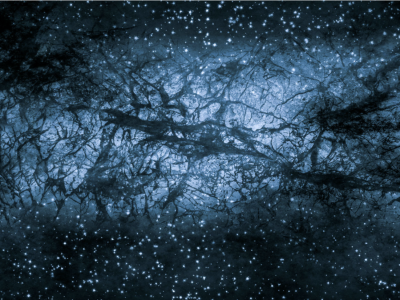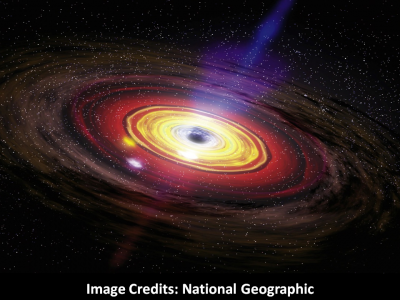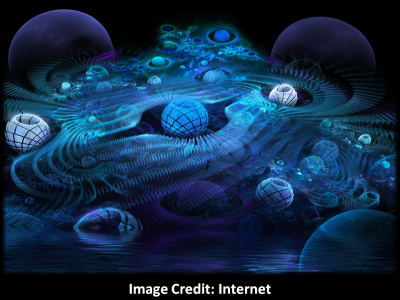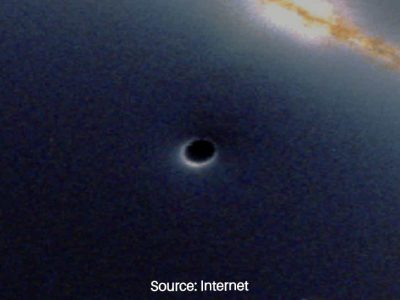
Dark Energy versus Dark Matter:
Dark energy makes up most of the universe, but dark matter is also present in a significant amount. It makes up about 27% of the universe and 80% of the total matter. So, it also has a crucial role to play.

The Dark Energy (Image Credits: newscientist.com)
Dark matter continues to baffle scientists like dark energy. While dark energy explains the expansion of the universe, dark matter explains the harmonious interaction between each group of objects.
In the 1950s, scientists studying other galaxies predicted that the central parts would rotate more than those on the outer edges of galaxies, given the distribution of objects within those galaxies. But they were surprised to note that both regions – the center and the edge – rotate at the same rate, indicating that spiral galaxies have a much larger mass than they appear.
The study of gases in elliptical galaxies revealed the spread of this hidden substance throughout the universe. Scientists believe in a number of different sources of dark matter, ranging from dark objects (stars that do not emit light, including brown dwarfs) to particles that differ in nature from known atomic particles.
Whatever the source of dark matter and dark energy, it is clear that the universe is under the influence of certain circumstances that scientists cannot perceive in conventional ways.
Diving in the Dark :
We live not only in a universe that is expanding, but we live in a universe that is expanding rapidly, and over the past five billion years, the rate of expansion of the universe has increased dramatically, and the universe has become larger by the day.
Scientists do not know exactly the cause of this acceleration, which was discovered when scientists were studying distant supernovae about 20 years ago. Studies have been rolled out to confirm this acceleration and prove its occurrence, including the radiation of the cosmic background, baryon acoustic oscillations, cosmic voids, etc.
Scientists have described the increase in the acceleration of the expansion of the universe as dark energy, known as one of the virtual forms of energy that fills space, and many theorists have tried to describe this energy and find its source.
An interesting idea suggests a type of quantum field responsible for dark energy, fields that absorb everything in space and generate all the forces and molecules in the universe, and unlikely that a quantum field will cause an increase in the acceleration of the expansion of the universe.
Resolving the contradictions :
As mentioned above, quantum fields may generate dark energy, an interesting hypothesis with some flaws and disadvantages. But before we talk about them, it is necessary to discuss the theory of strings.
The theory of strings is an attempt to unite all the forces in nature under a single mathematical scientific interpretation and explain the composition of the universe according to complex mathematical equations, i.e., “theory of everything”.
The theory tries to combine quantum mechanics and general relativity as it indicates that each particle and every force present in the universe is made of a single component and that the basic unit of the formation of matter is micro-vibrating tendons that we have not yet been able to monitor.
It should also be noted that the theory of tendons assumes that the universe contains additional dimensions because the tendons need more space to vibrate, especially with the size and diversity of our large universe.
This theory also faces many criticisms and is not classified as a complete theory of nature, as we still have no idea how these additional dimensions are and how they wrap around each other, and possibilities lead to about ten possible arrangements, and each one creates a new set of physics. Since we live in a single universe with one physical group, one of those configurations will be ours. But what composition?
Some scientists have tried to rule out some possible configurations of supposedly wrapped dimensions because they certainly do not form the universe. One of the main problems is that the dark energy generated by a single quantum field runs counter to the theory of strings.

Image Credits: Earthsky.org
Uneven darkness :
It is also not possible to say that string theory is the theory of everything or theory that explains the universe if you cannot predict a universe that contains dark energy.
Perhaps our understanding of what dark energy is, as a recent study suggests. They may be the result of a combination of quantum fields that operate harmoniously among themselves and are not the result of a single quantum field. This may sound complicated!
But remember that nature is not obliged to be simple and easy to understand.
By allowing a range of quantum fields to generate dark energy, this subtraction may relink string theory to the universe, and this model will not be incompatible with it. But this means that we find other factors causing dark energy.
Surely, there are some significant questions about dark energy. I am going to talk about the most interesting one:
Did the dark energy cause the Big Bang?
According to cosmologists, the mysterious force behind the acceleration in the expansion of the universe (what we call dark energy) is constant. A recent study assumes that dark energy has changed in the past and that those changes filled the universe with the molecules we see in our lives today. Nowadays, it occurs in our being a strange phenomenon. It expands even though it is full of matter.
The gravitational forces of matter must slow the expansion of the universe over time. But that’s not happening. Rather, it’s accelerating!
Over time, our universe becomes bigger and bigger, and its expansion accelerates further. Astronomers call this phenomenon dark energy because we have no idea what caused it, its source, or its behavior. All we know is that it appeared about 5 billion years ago, and it still remains today.
We also know that during the past five billion years, the forces of dark energy have remained constant. But the early universe was a stranger place, and things might have happened stranger for a long time and could have enormous implications for the rest of the universe’s history.
Then it was the light!
We don’t know anything about what dark energy is or why, but we know that it is responsible for accelerating cosmic expansion, and our universe is now old, cold, and coming to an end.
This great exclusivity means that there is not much energy (whether dark or other) to dissipate across the universe. If dark energy changes over time, it will not have a significant impact, because it is too weak. It indeed accelerates the expansion of the universe, but with a faint and simple effect, which is why it takes us so long to realize its existence in the first place.
This weakness is related to what dark energy can do, what we can know about it, and dark energy has not many effects to measure for astronomers. But the early universe is different, as it was hotter, thicker, busier, and more importantly: more active.
Dark energy emerged in the cosmic landscape 5 billion years ago, but that was not necessarily its first appearance, perhaps present and active in the early universe, and do a lot of exciting things before it settles into the cosmic background.
Recently, a team of theoretical physicists thought about what dark energy had done and published their findings in a research paper published on arXiv.org in November 2019. The researchers found that early changes in dark energy may have filled the early universe with particles such as quarks, gluons, and leptons, which later turned into the atoms we know today.
According to this research, this flood occurred after the inflation phase, when the early universe expanded in a very short period. According to this research, this flood occurred after the inflation phase, when the early universe expanded in a very short time.
Then the universe was empty, and then everything that formed before the inflation process exploded. It is called the reheating process, which paved the way for the big explosion. It is called the reheating process, which paved the way for the big explosion.
A team of physicists believes that what caused inflation is the same as what caused the reheating, but the new study suggests that early dark energy may have created the particles that filled the universe through energy loss.
Suggested Reading: To The Edge Of Space
Author













[…] Suggested Reading: Is there more than some kind of Dark Energy? […]
[…] Suggested Reading: Is there more than some kind of Dark Energy? […]